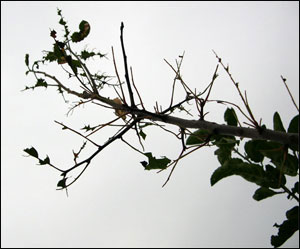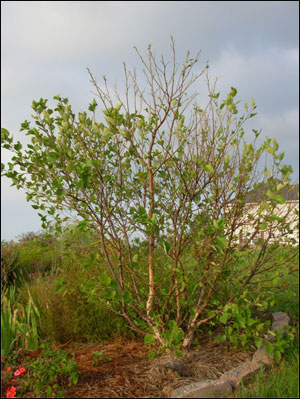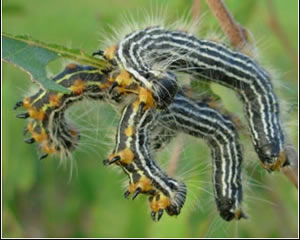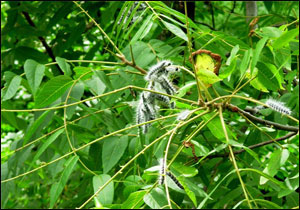Taking an environmentally sensitive approach to pest management
Vanishing Leaves
Published: September 1, 2011
Homeowners are commonly alarmed in early fall to find that the leaves on trees in their landscapes seem to have disappeared overnight. There are several possible culprits to blame for this vandalism, the most common being colony feeding insects, such as walnut caterpillar and yellownecked caterpillar. The adult moths of these two closely-related insects look very similar and both have larval stages with caterpillars up to 2 inches in length in their final instars, before pupation.

Eggs of the walnut caterpillar are laid in early summer in groups of up to 300 on the undersides of leaves of favored hosts such as walnut, pecan and hickory. When the larvae hatch out, they begin to feed on the foliage of the host. Since they are only ¼ inch long, the damage is usually not noticeable at first. However, in the second, through fourth instars, "skeletonization" of host plant leaves by the dark red caterpillars begins to become more obvious. After feeding, there may be nothing left but the midveins of the leaves or even just the petiole. Walnut caterpillar larvae are gregarious until the final instar. Often, they will move as a mass to a point on the host tree and shed all of their skins together, forming a hairy mass. Full grown larvae are up to 2 inches long with a black body covered with long white hairs. Soon after reaching this stage, they drop to the ground to pupate. The amount of foliage consumed by the final instar larvae can be impressive.

The female moth of the yellownecked caterpillar lays eggs in mid-summer on the undersides of leaves of a wide range of host plants, including birch, maple, crabapple, oak, cherry and many other species. As with the walnut caterpillar, the larvae consume large amounts of foliage in a short time as they near the final, 2-inch-long stage. This is when the foliage on a small tree can seem to disappear overnight, even though feeding may have been occurring for several weeks. The final stage larvae are very dramatic-looking with black heads, yellow bands on the prothorax (neck) and longitudinal yellow or white stripes. They are even more dramatic when disturbed, since they appear to rear up their heads and tails.
Although the damage caused by colony feeders like walnut and yellownecked caterpillars may appear drastic, it is rarely life-threatening. If a small tree is defoliated several years in a row, it may be weakened to the point that it will decline. However, since the damage occurs late in the season, trees will have begun to store carbohydrate reserves in their stems and will be able to grow new foliage the following spring. It might be worthwhile to make a note on your calendar to check affected trees the following summer. When the caterpillars are small, they can be controlled by Bt (Bacillus thuringiensis) which will not have negative effects on beneficial insects.


Subscribe to receive similar articles sent directly to your inbox!
- Red Berries Brighten Fall Landscapes (10/06/23)
- Vanishing Leaves (09/01/11)
REVISED: September 29, 2015